Text






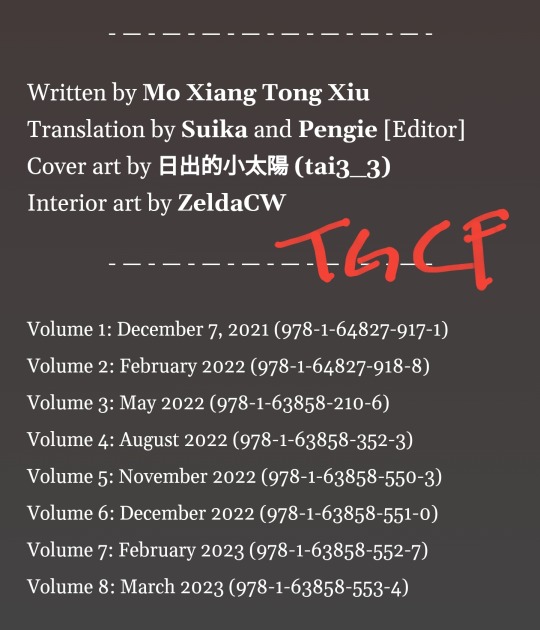
ALL THREE MXTX NOVELS ARE GOING TO BE OFFICIALLY PUBLISHED IN ENGLISH, THIS IS NOT A DRILL, IT'S REAL AAAAAAAAAAHHHHHH
Here is the link: http://sevenseasdanmei.com/
Also, please check suika's tweet for more details: https://twitter.com/yummysuika/status/1422968206420021253
9K notes
·
View notes
Text
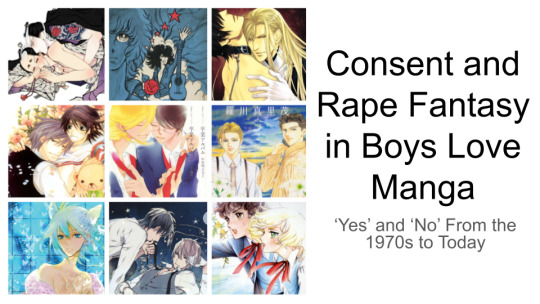
Hey everyone, here are the slides from my FujoCon 2021 panel, "Consent and Rape Fantasy in Boys Love Manga" including my bibliography! Putting together and presenting this panel was definitely a learning experience, and I hope all of you get something from it, too.
12 notes
·
View notes
Text
FeministFujoshi at FujoCon June 11th!

Hey everyone, wanted to announce on here that I'll be presenting a panel this summer at FujoCon, a free virtual convention for BL fans running the weekend of June 11th-13th. My panel will be exploring the depiction and function of sex, consent, and non-consent in BL manga from a more theory-based interrogative perspective (as opposed to a critical one.) I'll update this post with the panel date and time once it's scheduled, but if you can make the con at any point I highly recommend it; they've got a lot of great guests, including Scarlet Beriko as the guest of honor. Register online here!
EDIT: Panel date and time is June 11th at 3:30PM CDT! Hope to see you there!
15 notes
·
View notes
Text
Updated the 100% Consensual BL List!
Renai Nante Yurushimasen!
Fuyou Kareshi
At 25:00 in Akasaka
In August
If I Could Touch Your Heart
Meow For Me
Click through for summaries, notes and warnings!
7 notes
·
View notes
Text
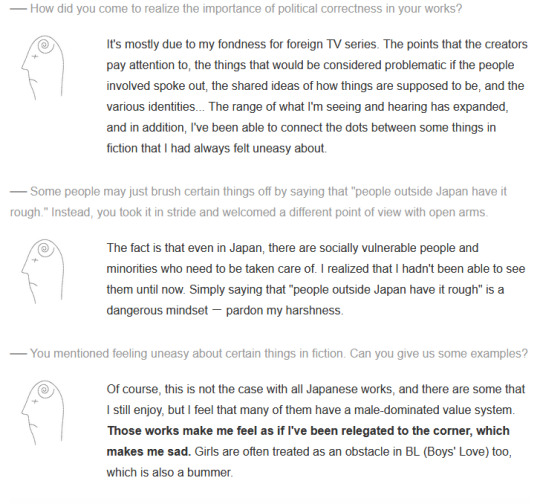
Yamashita Tomoko on The Night Beyond the Tri-Cornered Window and how she deals with social/political themes in her work
68 notes
·
View notes
Text

This was a really fun surprise--a few roadbumps, but full of likable characters with a refreshing variety of perspectives on sex work. "Lesbian-style boys love" is right up my alley!
7 notes
·
View notes
Text

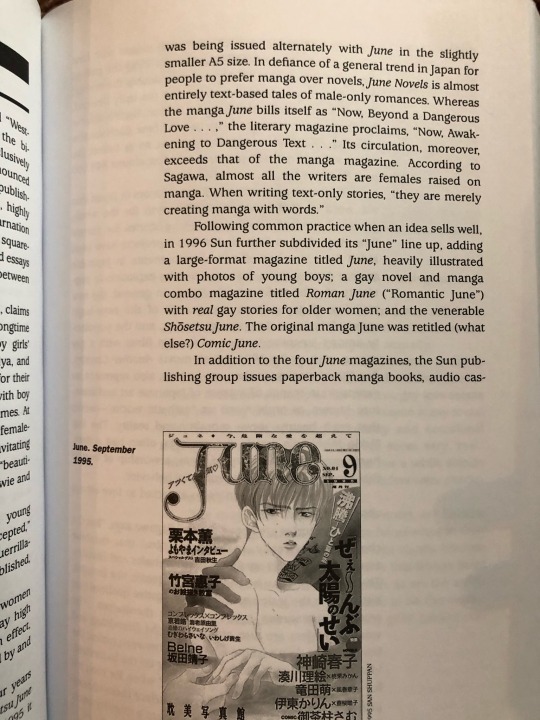

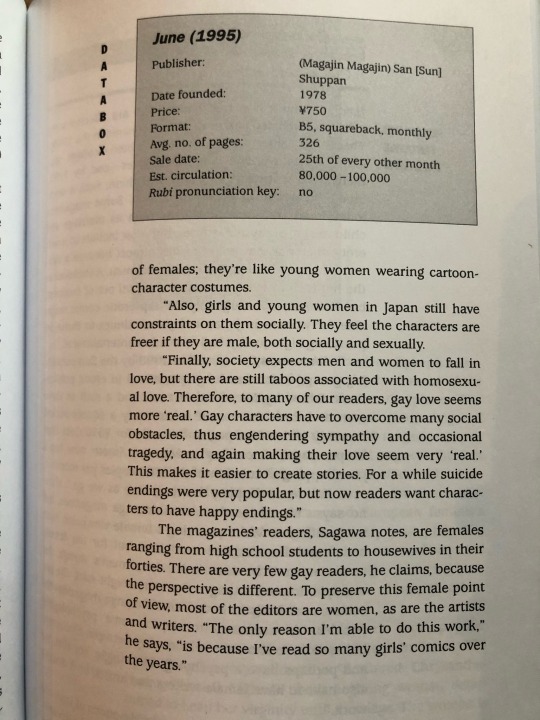
Dreamland Japan by Frederik L. Schodt (1996)
The meeting with the BL editors was a look into BL publishing and fandom today, then this meeting with Toshihiko Sagawa, former editor at June is a brief look into what early BL publishing was through the lens of one of the most pioneering magazines in the genre. Note how Boy’s Love and yaoi are not used as BL was still not yet widely used, and as we know yaoi is a work reserved for self published content of any kind
14 notes
·
View notes
Note
I have to say, one of the oddest things about western fans who “hate” (idk how much you can dispose someone while actively engaging with all of their works) MXTX is this assertion that she’s just a fetishizing straight woman (a thought that trickled over from white—ha!—ppl in fujoshi discourse). Because even though I’m not Chinese or Japanese, I have friends who are, and they’ve said the reason why ppl who consume BL keep it under wraps is not only because they’re consuming gay content but also because it’s assumed they won’t be straight themselves. The Actual stereotype is that MXTX as a BL writer, within the context of China, probably wouldn’t be regarded as straight. So this whole anti agenda just reeks of western cultural hegemony and racism to me.
Hi anon,
I am no expert on these topics which are quite complex and multifaceted, and certainly do not have possess the cultural context to comment on the everyday perceptions of people who engage in BL in Japan and danmei in China. But let me say that I do find a certain irony that the same people who will label BL/danmei as “heteronormative” to argue it is homophobic will absolutely ignore the tensions that arise out of the fact that as a genre mainly produced and targeted at women, BL/danmei disrupts heteronormative schemes of desire and norms. It is from there that the sense of “abnormality” or of disruption originates, the one that explains the existence of the term “fujoshi”.
Originated in the 1970s, this now fully matured BL subgenre has been viewed as a way to express repressed female desire and create alternative narratives for women under patriarchal society by its bold utilization of the female gaze and its subversion of heterosexual conventions (Aoyama 1988, McLelland 2000, Nagaike 2003,Wood 2006).” (Wang 2019:47)
In her groundbreaking research on danmei fiction, Feng Jin demonstrated that danmei fans sought excitement in transgressing the boundaries of conventional heterosexual romance and undermining established gender and sexual norms. (Ni 2018:10)
So it is not really surprising that I, like you, have heard some Chinese diasporic people discuss that they do not feel like they can let their parents or family know of their interest in MDZS/CQL without risking bringing attention to their sexual orientation. That being said, and while I cannot talk to the everyday perceptions of BL/danmei fans in their cultural context, all the media studies works I’ve read on the topic tended to emphasise that the majority of BL or danmei fans are heterosexual. Of course, it is difficult to take these things as absolutely conclusive, because a lot of factors (such as stigma and discrimination) may influence this perception that straight women represent the majority of fans.
The thing I think that is often forgotten is that depictions of homosexual love or even same-sex experiences are not necessarily always received as a real or at least threatening disruption heteronormative order. Lesbian porn, for instance, does not displace women as objects of male desire and of the male gaze: it is thus not transgressive and there is nothing that is felt to be abnormal about a straight male consuming these works. In another line of thought, sexologists in early modern Japan framed some same-sex romances between the then-new shoolgirls as a completely normal part of their development, as a “kind of rehearsal for entry into adulthood, that is, heterosexuality and motherhood” (Suzuki 2010:27). However, at the same time, “postadolescent ome relationships, in which masculine and feminine roles were visibly defined [between female partners], were considered ‘abnormal same-sex love’ (hentai douseiai)” (idem). Perhaps mind-boggling for the tumblr university of queer studies but sometimes, due to spatiotemporally-specific contexts, a relationship between two people of the same gender that reproduces the gender presentation and roles of heterosexual relationships can actually be felt to be more of a threat to heteronormativity (in this case because it showed a sense of gender ambivalence that precluded one of the women from entering into normal married heterosexuality and because it offered a plausible alternative to heteronormative institutions like the reproductive heterosexual family). So even depictions of homosexual relationships between men, generally made for and by women, may actually be received as a disruption to heteronormative norms in some contexts--partly because of how female desires are made normal or abnormal in that iteration of heteronormativity. Things are complex, specific and shifting. Nothing about the social perception of sexuality, desires or same-sex love is static or global. Neither are heteronormative institutions.
To me it does not mean that BL or danmei are genres above criticisms, or that the fact that they can represent subversive and empowering genres for women, some of whom are queer, means that they do not have the potential of being at times homophobic or even transphobic. At the end of the day, my take on this is simply that considering the complexity of the context surrounding BL and danmei (a context that can be difficult to access or understand for Western fans) is necessary for critiques to hold any weight, and that we are poorly served by an all-or-nothing mentality. Dismissing from the start a work of fiction because of its association with a genre, without actually looking at what is in the text, is just lazy and dogmatic? And yes, may reek sometimes of the entitled white attitude that they, unlike the backward Other, know a thing or two about queer representation.
And those are my two cents to take, as always, with a grain of salt.
---
Ni, Zhange (2018) Steampunk, Zombie Apocalypse, and Homoerotic Romance: Rewriting Revolution Plus Love in Contemporary China(working paper)
Suzuki, Michiko (2008) Becoming Modern Women: Love and Female Identity in Prewar Japanese Literature and Culture. Stanford: Stanford University Press.
Wang, Cathy Yue (2019) Officially sanctioned adaptation and affective fan resistance: The transmedia convergence of the online drama Guardian in China. International Journal of TV Serial Narratives (V:2): 45-58.
96 notes
·
View notes
Text
@saniwa I’m finally reading the BL Textbook (BLの教科書) and just the first chapter about genre terminology by Fujimoto Yukari is really interesting. Basically in english we have been generally taught that the categories yaoi and shounen ai were divided by yaoi having explicit content and shounen ai doesn’t and is more sweet and chaste. but in Japanese they are more era dividers of stories of gay men aimed at girls. I’m just going to use this term a general descriptor of what we’re talking about to keep the terminology separate.
Shounen Ai 少年愛 generally covers the beginning era basically created by Hagio Moto Takemiya Keiko with Heart of Thomas and Kaze to Ki no Uta. As the actual foremothers of Dark Academia the european all boys school setting and influences like Aestheticism (耽美), and the other uhhh questionable influences of A Death in Venice etc. sets their works apart from just about anything else at the time and the floodgates open for more of these types of stories to enter Shoujo manga magazines. The year 24 group in general are especially characterized by their shounen ai fascination.
In 1978 the magazine June is established notably with a cover by Takemiya and she gets a regular “Manga classroom” feature in it. The magazine features original manga and serialized novels and this is where we see Shounen Ai primarily develop and come to its own. Author of the Guin Saga, Kaoru Kurimoto also becomes a prominent figure in June under the pen name Azusa Nakajima. She draws interest to the blossoming genre with stories and essays. June manga continues the Aestheticism influence to the point where its type of stories were also called Tanbi (耽美) or simply Aesthetic. Apparently this term stuck around a bit in Chinese fandom.
By the late 70’s early 80’s Comiket comes to its own, whats notable about this era is how the majority of attendants are actually women! Publishing their own original shounen ai derivatives works the term Yaoi (やおい) pops up as we know beung an abbreviation of 山なし落ちなし意味なし no climax, no conclusion, no meaning. And this isn’t just for funsies (which it was too BUT) its also a statement about how Yes! This is completely self indulgent and devoid of structure! If I understand right its also the actual feedback some of these self published authors got from editors when they tried submitting their works to magazines. For a while Yaoi mainly referred to self published content, then as “parody” or derivative fan works gained prominence as more anime also equally appealing to an older audience started airing its usage spread even more. Yaoi became a common denominator for fan works but then the Tsubasa Boom happened in the second half of the 80’s, this is when these characters
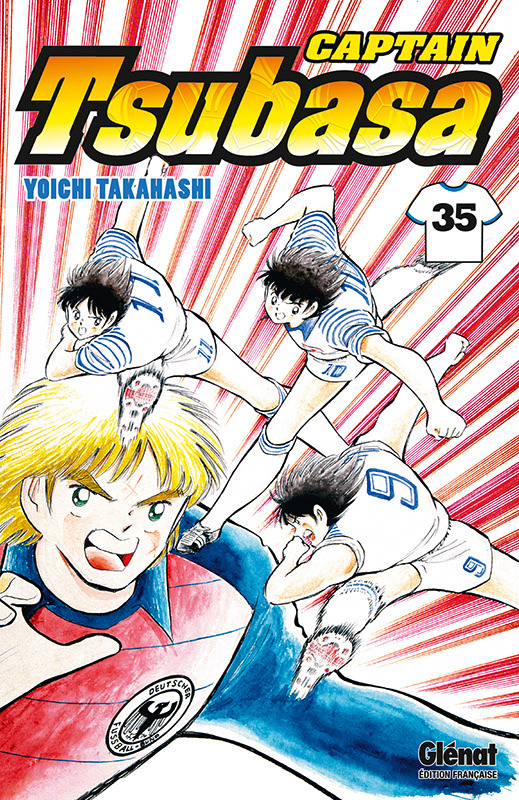
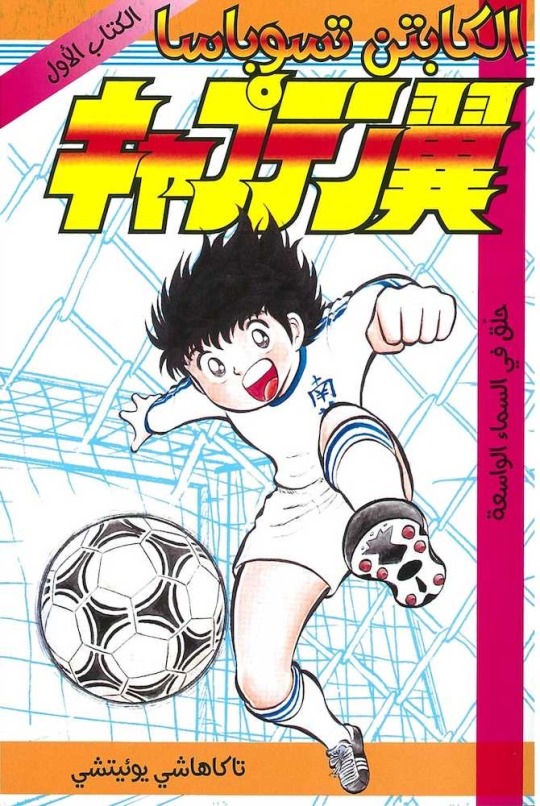
Were depicted like this in doujinshi
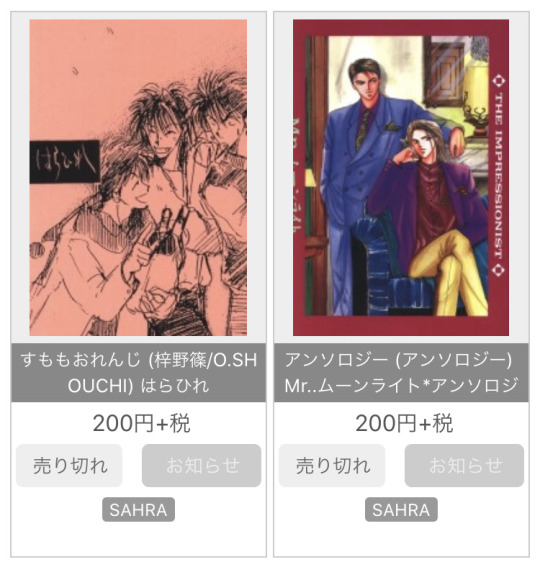

(Mandarake does not tag by year so assume most of these are early 90’s actually) Now that there was an increase in fanworks based on series from a boy’s magazines there was a need to mark the fanworks that are romantic or even explicit so the creators would mark theirs as “やおいあり” “contains yaoi”. Basically this is where we first see Yaoi being used to mark that a work is explicit. This fandom is also credited with starting that whole thing about being super militant about who in the pairing bottoms or tops.
Boys Love as a term then comes about in the 90’s when there became a bigger space in professional publishing for Otoko Doushi content. Its kinda made a thing by a animanga news magazine and a new magazine that marked itself as “Boy’s love comics”. June also goes on a publishing hiatus around the time and while they’re gone commercial BL at large blossoms, and notably there’s a decrease in the tragic tropes present in a lot of June stories and more happy endings. Another thing to note is that as BL carves a bigger space in publishing we see these stories completely disappear from shoujo manga which is a trend has only reversed in the recent decade.
So basically while these terms describe the same thing being stories about gay men aimed at women but they’re mainly divded by time more than content tho they obviously have their own nuances and tropes attached. This also super abbreviated so check out BLの教科書 or the jp wiki page for yaoi for more details
164 notes
·
View notes
Photo


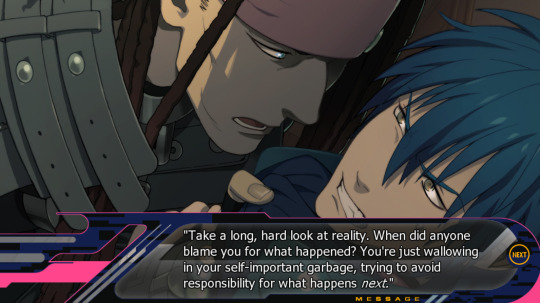
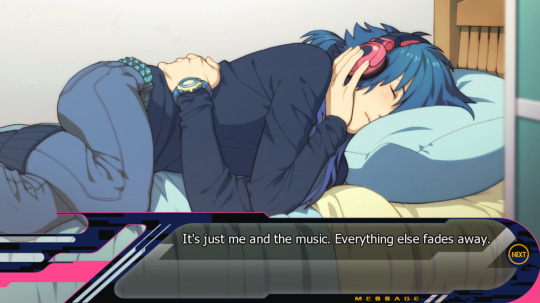



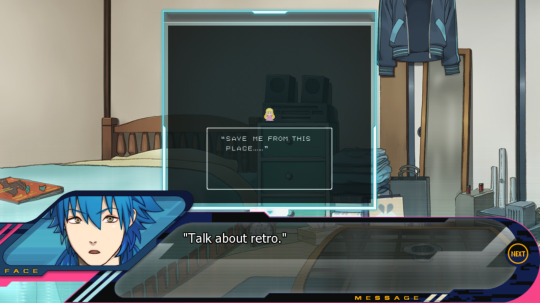
Megahit Visual Novel DRAMAtical Murder Soon To Be Available In English
The Boys Love visual novel phenomenon DRAMAtical Murder is being officially released in English for the first time. Renowned for its bright cyber-pop visuals and dark, compelling storyline, DRAMAtical Murder has been hotly anticipated by English-speaking BL fans worldwide.
“We’re so excited to share this incredible game with players, and know they’ll fall in love with the cast of memorable, gorgeous characters while determining what twists the story will take,” said Mary Borsellino, Director of JAST BLUE, the Boys Love imprint of visual novel publisher JAST USA.
Since its original release by Nitro+CHiRAL in 2012, DRAMAtical Murder has been adapted into a successful live-action stage production in Japan and a popular anime series available internationally through Crunchyroll and Sentai Filmworks.
Release Details
A hardcopy 18+ edition of DRAMAtical Murder is now available for preorder and includes a digital artbook, original game soundtrack CD, and a Steam key in addition to the physical game. Preorders receive two limited edition character badges.
The title will also be available digitally in an edited form through Steam and uncensored through the JAST USA website. A patch to restore content cut from the Steam edition will also be available through the JAST USA site.
Review Copy Available
To obtain a review copy of DRAMAtical Murder, please contact [email protected] for a download link.
About DRAMAtical Murder
The beautiful island of Midorijima was once a place where people lived in harmony with nature, until the Toue Corporation took over and forced the island’s residents into the shadow of Platinum Jail, a walled-off megaresort where the wealthy wallow in luxury.
Aoba is a young man living with his grandmother, working part-time in a junk shop while his peers join gangs or immerse themselves in virtual reality. All Aoba wants is a peaceful life, but strange things are happening in Midorijima, and soon he will have to fight… or lose everything that he holds dear.

464 notes
·
View notes
Note
I found the link to your Harada post on Twitter but it looks like its been deleted?
Hi, thanks so much for asking! Unfortunately tumblr mobile ate all the edits I made to the Harada piece before I posted it, and I wasn't happy with the unedited draft--it lacked specificity / cohesion / analytical rigor. It'll go back up eventually, once I have the time and motivation to re-write it, but it'll probably be a while.
3 notes
·
View notes
Note
Your post on Nii-chan was very thoughtful and well-written. I have a question, though. Do you know if Harada is a woman? I know people tend to assume all BL mangaka are female, but I thought Harada hadn't disclosed their gender anywhere.
Thanks so much for the ask, anon! I've definitely heard this claim before but totally forgot about it while writing the post 😳 mangaupdates does list their gender as female, but that's not exactly a bulletproof source. If anyone knows more about this than I do or can read Japanese and find references to Harada disclosing or not disclosing their gender (maybe on their twitter?) let me know! Otherwise I'll edit the post to remove the gendered pronouns I used for them. Thanks again!
0 notes
Photo

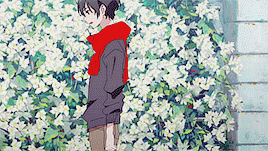
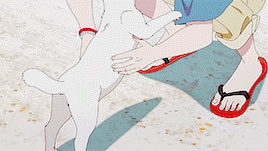
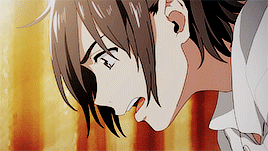


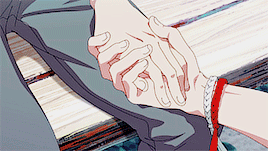
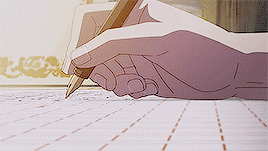


UMIBE NO ÉTRANGER [PV]
—September 11
193 notes
·
View notes
Photo

Twittering Birds Never Fly Volume 4 to release in December 2020!
Juné made the announcement on Twitter. The manga will be available in print and digital format. The first print run will come with an exclusive extra, though only for a limited time!
181 notes
·
View notes
Text
Fujojocast no. 15 - Diversity through Futekiya
In this episode of Fujojocast, I’m joined by Emma Hanashiro from @futekiya and we talk about how their website aims to help diversify our BL reading needs. Fujojocast #15 - Diversity through Futekiya
Futekiya’s Library
When things look glum, it’s nice to find the light at the end of the tunnel. If there is one thing great about the world right now is that BL is growing and has become increasingly accessible.
When English-translated BL used to be handled by a select number of companies, some of which have consistently given us heavy hitters while others have broken our hearts, in the last…
View On WordPress
6 notes
·
View notes
Text
Disturbing, Traversing, Borderless, Shaking Sexuality: The Place where Revolutionary Girl Utena was Born
Mari Kotani: You know, I like bondage stuff (laugh). Basically, I like deviation, I want to escape away, but if you are not oppressed there is no way to escape. In order to deviate, you have to first be tied up. The Black Rose Society particularly emphasizes that, doesn't it? You have some worries, so first of all, someone will slowly look them over. Places of surveillance as places of bondage—e.g. a military unit, a monastery, or a dorm becomes an excellent stage setting, right?
Kunhiko Ikuhara: I like it too. But by deviance, do you mean sexual deviance?
Kotani: Deviance from the system. A community with rules, where there is someone like a dorm supervisor who runs a tight ship, and you escape from it....As a concrete example, when you pick two male characters from an existing work (a manga, novel, TV drama, or phenomenon) and depict a love story between them, we call that "yaoi", and it is extremely common for yaoi-stories to take place in schools. Utena is set in a school too, right?
Ikuhara: The reason for that is extremely simple. For girls, places like schools are the only social communities that have any reality to them.
Kotani: Right. It's a world where you can easily see the system that ties people up. I think that's exactly why stories about deviance so often choose such settings.
20 notes
·
View notes
Link
Hey everyone! I promise I’m (still, I know, I know) working on something for the blog–fingers crossed it’ll be up soon! In the meantime, feel free to suggest titles for me to add to the wishlist for my own and others’ future reference. If you do decide to buy something, do keep in mind that titles licensed in English will be written about before Japanese-only titles, but everything I recieve will be written about eventually. Thank you all so much for your patience and support regardless!
0 notes